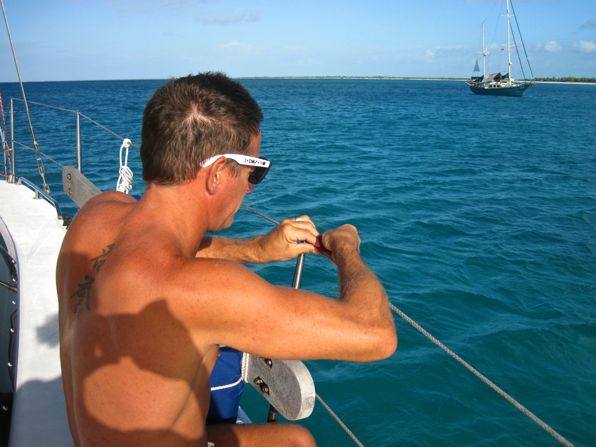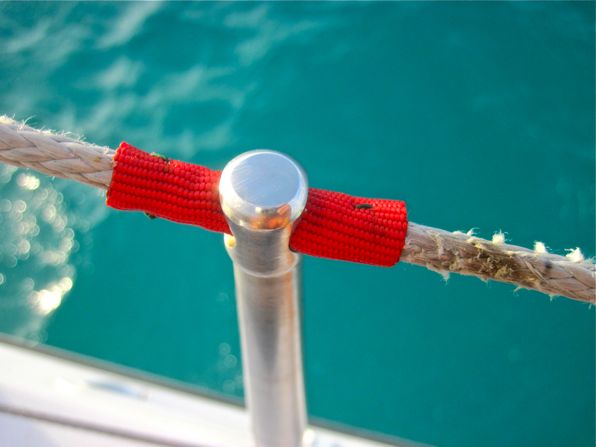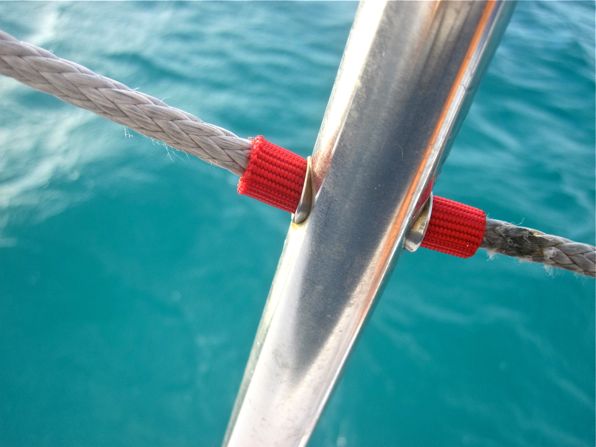On chafe protection
I think it was Bob from the blog Windborne in Puget Sound who said “the first solution is never the best solution.” I have definitely found this to be true in many of the projects that I have taken on.
There was some discussion on here about the risk of chafe on our synthetic lifelines as they pass through the stanchions. If I was to do the job of installing them all over again, I think I would attempt to use the cover off some slightly-larger-diameter double-braid line to add protection to those vulnerable areas. I believe this is a better solution than using pieces of hose that was suggested, my thought being that the rigid pieces of hose would present their own potential to chafe the line.
Now, although I have yet to try this, my idea is to first remove the core on a piece of double-braid and then thread the Amsteel lifeline back though small sections of the now-hollow cover. Of course, this would need to be done in sequence as the lifelines are first installed, which is why I can not use this method now (there are eye splices in each end of our lifelines which prevent them from being removed).
My alternative solution for our current installation, using materials that we already had on board, was to wrap small pieces of nylon webbing around the Amsteel and then slide it into the holes. This took a little bit of trial and error to find the perfect length of webbing which, after wrapping around the lifeline, would fit inside the stanchion’s hole, but I ultimately worked it out (on our boat, for 1/4″ Amsteel, they need to be 1 3/4″ long). After cutting each piece of webbing to the correct size, I melted each end so that the material would not unravel. By taking my time to wrap each piece of webbing around the line tightly, I was able to get them in place without much difficulty.
Once I had each chafe point protected, I began to think how I could best secure the pieces of webbing so that they remain in place. I’m not entirely sure that they will move without anything further being done to them but just in case, I put a couple of lock stitches through the webbing and line to hold it in place and to keep it wrapped tightly. Remembering that the first solution is seldom the best one though, I only did this to two of the webbing pieces. I’m waiting to see if a better solution presents itself in the next couple of days.

Trimming the webbing to size. I then melted the ends to prevent fraying.

Wrap each piece tightly around the lifeline.

Sliding it into place.

The finished product, with a crude lock stitch to hold the webbing in place…

…and without.
Note: I noticed today (February 10, 2012) that when pressure is applied to the lifeline, it slides nicely inside the pieces of webbing while they remain stationary. Obviously if I lock stitch them all in place that will not occur.



If the webbing is not stiched in place, won’t it eventually work its way out of the stanchion?
How about using the webbing length wise, making it stick out of the stanchion far enough that when pressure is applied the webbing is still inside the eyelet? That way, with it stiched to the lifeline, all metal to lifeline chafe will be borne by the replacable webbing.
Can you make your way up Mobile Bay to help me with some sheetrock finishing and minor shingle repair! On water or land all homes need care!
I don’t know if it would eventually work its way out. Perhaps.
As for helping with home repair, I am the last guy you would want to enlist. I ain’t that handy!
Mike, this looks like a great idea! I tried some heatshrink around my amsteel in chafe-prone places, but it didn’t quite work.
Maybe you should stitch the webbing to itself (so that it stays tubular) and lock-stitch it to the stanchion (so that it doesn’t travel with the amsteel)?
Total n00b opinion, so take it for what it’s worth.
The choices are:
lock stitch and the webbing moves in the stanchion
don’t lock stitch and the amsteel moves inside the webbing.
Decisions, decisions.
Sweet.
I’ve used this stuff (http://www.rei.com/product/610111/bluewater-916-climb-spec-tubular-webbing) to sleeve over 5.5 mm Kevlar climbing cord, way back in the day, and it was very durable. I think that is what I will try. You’ve gone 2-layer, so it should last as long as the lines have any life at all. Certainly FAR more durable that rope cover.
BTW, I like the idea of letting the Amsteel slide inside to tubing. That’s how I’ve always rigged dock line covers, and my last set of dock lines lasted 15 years! In fact, they were like new under the covers where they lay in the chocks, but sun burned everywhere else. The webbing also lasted 15 years, but was in complete tatters.
I was introduced to the notion of using tubular webbing as chafe guard on climbing rope about 30 years ago. My first magazine article was on that topic in SAIL, way long ago.
Great solution.
I think I first saw webbing being used as chafe gear when I went rock climbing with a friend.
In fact, you gave me another idea!
I’m going to re-lace the tramp in a few months with 1/4-inch Amsteel. You sold me. However, I’ve noticed I’m having the same pull-out problem you were having in the center. Instead of using shackles, I was thinking of lacing through a new pair of holes, like the ones you drilled. I’ll countersink and smooth the holes, but they’ll not be perfect. This sort of sleeve will be PERFECT, and will easily bend around the corner, unlike and plastic tubing.
I’ve also used tubular webbing in place of thimbles on anchor lines and rigging; it is impossible to fit a thimble if the line is knotted rather than spliced, and then webbing becomes the only answer.
Something to remember. A good anwser for chafe many places.
I agree. Looking forward to seeing pics of your new tramp lacing.
Leather glove leather works perfect for this app. I used it on my trimaran for over 20 years in the Caribbean. Also tied leathers over my three stranded mooring bridle where it passes thru the chocks…( Hand stitched….But could use contact cement if overlapped enough )…..still looked and worked good after 20 years without replacement…..enjoying your blog from the Mountains of Wyoming……19.00 BEER….WHERE WILL IT STOP!! smile….
Leather sure would work but the webbing I had on hand though so it cost me nothing to put together. I think it also looks pretty cool.
Hope all is well. You probably know they sell covers made for 12 strand Dyneema (AmSteel). Yale and others have thin sleeves which would work very well. I am about to tackle this job on my boat, I may just cover the whole thing. Thoughts?
To be honest I was not aware although it doesn’t surprise me. If I was to do it again, I would definitely add some sort of chafe protection while installing the lines.
You’re so clever.
Gracias!
Mike, I’d think that it’d be better to lockstitch the webbing. That way if there is chafe, it’ll occur on the replaceable webbing, not on the Amsteel…
And thanks for the cite 🙂
bob
s/v Eolian
Seattle
You’re welcome, Bob, and thanks for sharing your thoughts!
I’m considering press fitting a PTFE teflon bushing into the stanchion when I do the Dyneema thing.
I think you can now purchase items like that specifically for this purpose. The trick is to put them in as you’re doing the splicing because once that’s done, it’s too late.